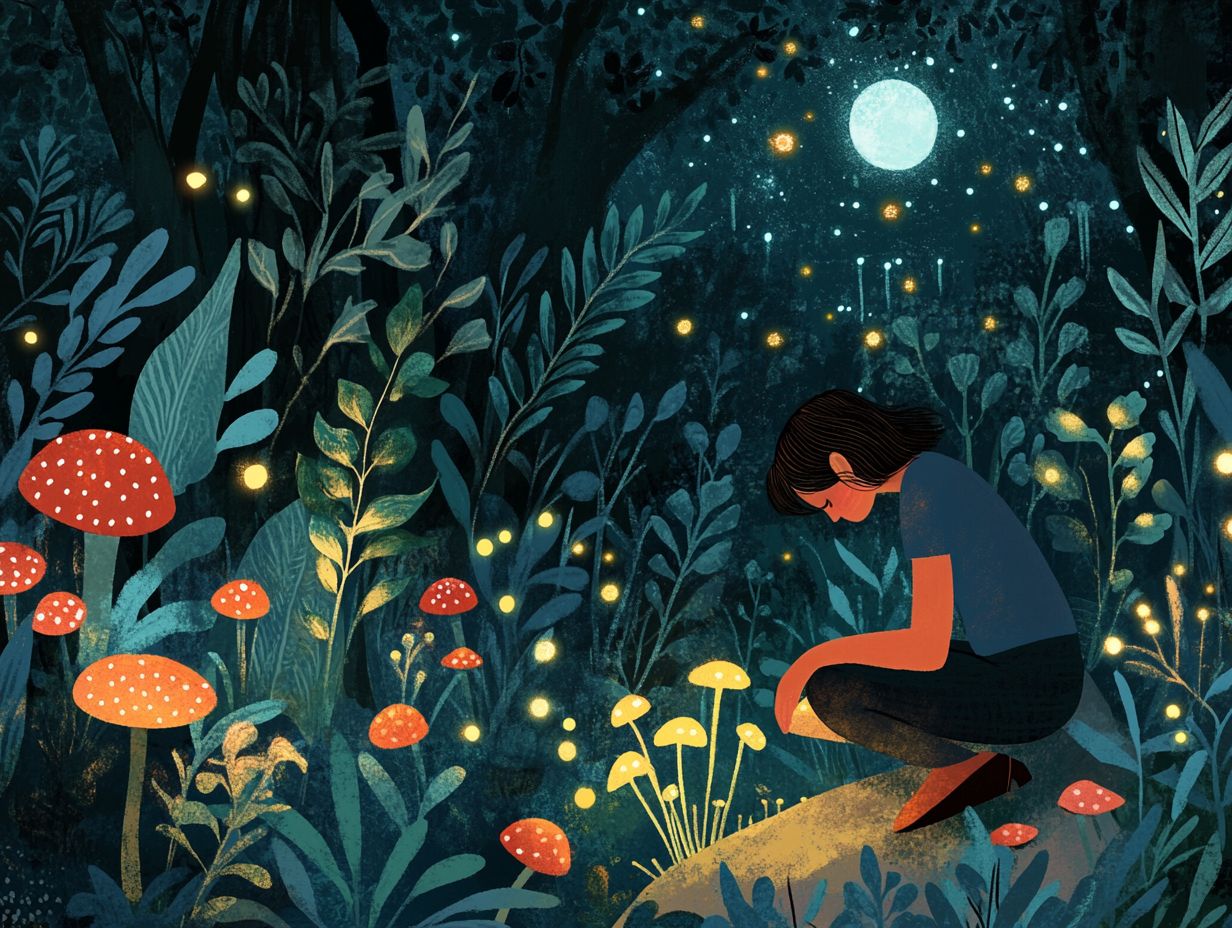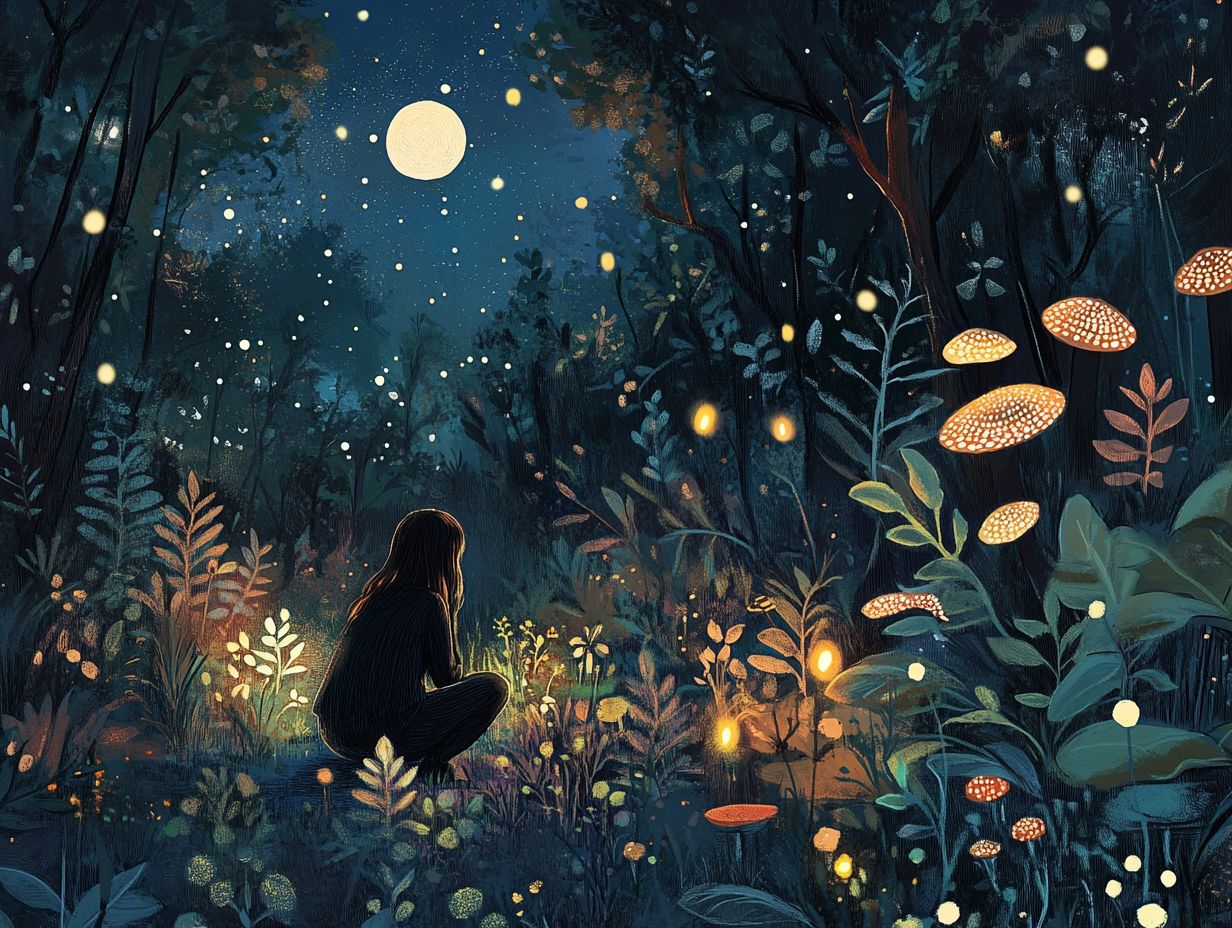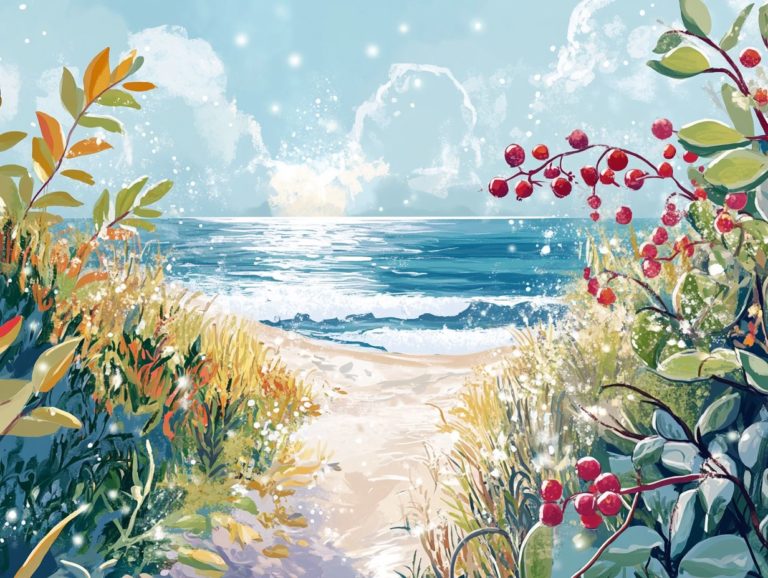What Are the Best Times for Night Foraging?
Night foraging unveils an enchanting realm of exploration, granting you the opportunity to connect with nature beneath the gentle glow of the moonlight.
Uncover the essentials of night foraging what it entails, its many benefits, safety precautions, and the optimal times for your outdoor adventures.
Equip yourself with the necessary gear and discover tips that will elevate your experience. Whether you are a seasoned forager or a curious newcomer, this journey offers something for everyone eager to embrace the treasures of the night, including beginner foraging tips.
Contents
- Key Takeaways:
- The Basics of Night Foraging
- Benefits of Night Foraging
- Factors to Consider Before Night Foraging
- Best Times for Night Foraging
- What to Bring for a Night Foraging Trip
- Tips for Successful Night Foraging
- Frequently Asked Questions
- What Are the Best Times for Night Foraging?
- How do I know when it’s the best time to go night foraging?
- Are there certain weather conditions that make for better night foraging?
- Do different regions or habitats have different best times for night foraging?
- Is it safe to go night foraging in certain areas?
- What are some tips for successful night foraging?
Key Takeaways:

- Night foraging offers unique experiences. Always prioritize safety and environmental awareness.
- The best times for night foraging depend on moon phases and weather conditions. Planning can help determine the optimal time for a successful trip.
- When preparing for a night foraging trip, bring essential gear, tools, food, and water supplies to sustain you throughout the journey.
The Basics of Night Foraging
Night foraging presents a unique opportunity to blend the art of foraging with the mysteries of the night. It invites you to explore seasonal plants shrouded in darkness, fostering a connection with nature.
As a form of gathering plants from the wild, night foraging reveals the hidden beauty of plants that come alive after sunset. Participate in foraging workshops that focus on plant identification and ethical techniques to ensure your interactions with nature are respectful and enriching.
What is Night Foraging?
Night foraging is the practice of harvesting edible and medicinal plants at night, when their aromas and flavors are often at their finest. Seasonal plants offer unique tastes.
This approach unlocks a treasure trove of botanical delights, as many plants release captivating scents and flavors after sunset. For the night forager, navigating trails with a reliable headlamp while being aware of nocturnal creatures (animals active at night) becomes part of the adventure. Certain species, like wild garlic and mushrooms such as morels, are often easier to identify and gather in the comforting cover of darkness.
Unlike traditional foraging, which relies heavily on visual cues, night foraging engages your senses more fully. It highlights the importance of scent and sound when seeking viable plants. By understanding the habitats of these nocturnal offerings, you enhance your experience and boost your harvest in this food adventure under the stars.
Benefits of Night Foraging
Night foraging offers various benefits, from the distinctive flavors of nocturnal plants to the soothing effects of harvesting beneath the stars. This experience allows you to connect with nature in meaningful ways and discover the amazing medicinal benefits of the plants you find.
As you engage your senses, you’ll appreciate the enchanting beauty of the night and the rich variety of edible and medicinal plants that flourish after dark. These delightful finds can elevate your culinary pursuits while fostering a sustainable and ethical approach to gathering plants from the wild.
Don t wait! The wonders of night foraging await your exploration!
Why Forage at Night?
Night foraging opens up a world of flavors and health benefits often missed during the day.
As dusk falls, unique plants come alive. They offer flavors and textures that daytime foragers might miss.
The cooler temperatures encourage culinary delights like savory wild mushrooms and aromatic herbs to release their essential oils, enhancing their natural qualities.
Plants like night-blooming jasmine and wood sorrel are most potent at night. They provide health benefits like digestive aids and anti-inflammatory properties. Venturing into this nocturnal landscape allows for a rare connection with nature and sparks creativity in the kitchen. You can turn these foraged wonders into extraordinary dishes or soothing remedies.
Factors to Consider Before Night Foraging

Before you get ready for an exciting night of foraging, consider a few key factors for your safety and success.
Understand the environment, including current temperatures and master plant identification skills.
The nighttime environment presents unique challenges and opportunities. Being aware of your surroundings is crucial especially regarding potential encounters with wildlife or unexpected weather changes.
Taking safety precautions is vital to a rewarding night foraging experience. Equip yourself with the right gear and familiarize yourself with local plants.
Safety Precautions
When engaging in night foraging, prioritizing safety is essential. Darkness can conceal hazards and complicate plant identification.
Ensure your experience is safe and enjoyable by equipping yourself with essential gear like headlamps or flashlights. These tools not only light your way but also help you see plants clearly.
Sturdy footwear protects against hidden obstacles, and having a first aid kit on hand is crucial for minor accidents.
Stay alert to your surroundings. Listen for wildlife and watch your step to avoid accidents. Recognizing edible species is paramount. Use guides or mobile apps for plant identification to distinguish between safe and toxic varieties. This knowledge enhances your safety and confidence as you forage.
Environmental Factors
Environmental factors like weather conditions, moon phases, and wildlife activity can greatly influence your night foraging success.
These variables determine the availability of edible plants and mushrooms, shaping your overall experience. For instance, overcast nights may enhance visibility for certain species, while a full moon can deter nocturnal creatures that help in foraging.
Before setting off, assess the current weather patterns. Understand how they affect the local ecosystem. Plants respond differently based on moisture levels, temperature fluctuations, and specific animal behaviors. These factors can dictate where and when certain plants are abundant.
Best Times for Night Foraging
Determining the optimal times for night foraging requires a keen understanding of seasonal patterns and environmental temperatures that influence the growth of various plants.
By paying attention to these factors, you can enhance your foraging experience and ensure a successful outing.
Factors That Determine Optimal Time
Several factors, including environmental temperatures and seasonal changes, dictate the optimal times for you to engage in night foraging. This ensures a successful harvest.
Night foraging is closely linked to the growth cycles of seasonal plants and the varying temperatures that shift with the seasons. During warmer months, certain edible flora and fresh greens thrive, attracting enthusiastic foragers like you, eager to collect them under the cover of darkness.
Understanding how plant blooms and fruits synchronize with lunar phases, or the different stages of the moon, can significantly enhance your yield. As autumn cools, it signals the ripeness of specific crops, making night foraging a smart choice to target particular varieties while minimizing competition from those who prefer daylight excursions.
What to Bring for a Night Foraging Trip

Preparing for your night foraging trip involves thoughtfully selecting essential gear and supplies that will elevate your safety, comfort, and success in identifying edible plants and their roles in the ecosystem.
Essential Gear and Tools
Essential gear and tools for night foraging include:
- Headlamps
- Foraging baskets
- Plant identification resources
These items ensure your experience is both successful and safe, particularly during mushroom foraging adventures. Headlamps are crucial because they provide hands-free illumination, allowing you to navigate through dense underbrush while keeping both hands free for gathering mushrooms and other foraged items.
A quality headlamp should have adjustable brightness levels, enabling you to adapt seamlessly to various environments, especially when examining the sward structure of grasslands you might encounter.
Sturdy foraging baskets are essential; they not only assist you in collecting various edible plants and fungi but also ensure proper air circulation, which is vital for preserving freshness. Reliable plant identification resources, whether in the form of apps or field guides, are crucial for helping you distinguish safe edibles from toxic look-alikes. This way, you can confidently explore the nocturnal landscape without the worry of misidentifying potentially harmful species.
Food and Water Supplies
Bringing along adequate food and water supplies is essential for an enriching night of foraging, helping you sustain your energy levels and stay hydrated.
As you embark on this adventure, it s wise to pack nutrient-dense snacks that are easy to carry think:
- Nut mixes
- Dried fruits
Opting for lightweight, resealable water containers will ensure your hydration needs are met, especially when the physical activity ramps up under the enchanting moonlight. High-protein options like jerky or energy bars can also be invaluable for maintaining stamina during those extended hours of exploration.
Remaining attuned to your natural surroundings allows you to incorporate local edible plants, enhancing your experience and forging a deeper connection with the environment.
Tips for Successful Night Foraging
To enjoy a successful night of foraging, you need the right mix of preparation, knowledge, and expert insights. This combination enables you to navigate the nocturnal landscape with both confidence and enthusiasm, transforming your foraging experience into something truly rewarding.
Don’t miss out on your chance to discover delicious plants under the moonlight!
Expert Advice for a Productive Foraging Experience
Expert advice for a productive night foraging experience emphasizes the importance of understanding plant behaviors and being aware of what you see, smell, and hear to effectively identify seasonal flora.
As you immerse yourself in the darkness, your eyes will gradually adjust. This adjustment helps you detect even the faintest movements and colors of vegetation.
Complementing this visual acuity, your heightened sense of smell becomes an invaluable ally. Many plants release distinct scents that can lead you right to their location.
Understanding how different species react to changes in temperature and humidity can greatly improve your foraging success. Knowledge of local plants and wildlife is essential for any forager seeking to make the most of their night-time adventures.
Frequently Asked Questions

What Are the Best Times for Night Foraging?
The best times for night foraging vary depending on the species and location. For more detailed information, check out when is the best time to forage, as some animals prefer to forage at dusk or dawn, while others are more active in the middle of the night.
How do I know when it’s the best time to go night foraging?
One way to determine the best time for night foraging is by researching the specific species you are looking for. Many animal behavior patterns can be found online or in field guides.
Are there certain weather conditions that make for better night foraging?
Yes, certain weather conditions can affect night foraging. Typically, mild temperatures and low wind levels are ideal, as they make it easier for animals to detect prey.
Do different regions or habitats have different best times for night foraging?
Absolutely. The best time for night foraging can vary greatly depending on the species and their natural habitat. For example, animals in dense forests may have different foraging patterns than those in open fields.
Is it safe to go night foraging in certain areas?
Don’t miss out always be aware of your surroundings! It s crucial to be cautious, especially in unfamiliar areas. Keep an eye out for potential hazards such as steep terrain or dangerous animals.
What are some tips for successful night foraging?
- Use a red or green light instead of white light, as it is less likely to startle animals.
- Try to be quiet and move slowly to avoid scaring away potential prey.






